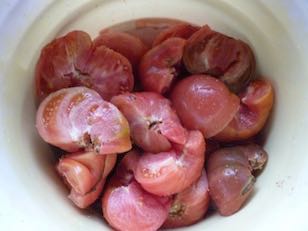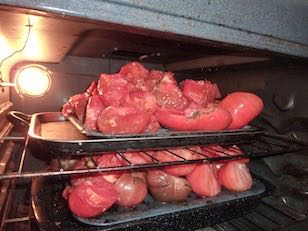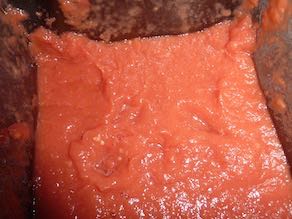Simple, Authentic Tomato Sauce
10/13/14 06:57 PM
It's been my goal not to be outdone by anything "store-bought," but when it comes to pizza, it has been really hard to contend with Stuc's Pizza in Appleton, WI. Whenever I'd get a "tastes like Stuc's" comment from one of the kids, I knew I was on the right track. What makes that sauce so unique, so bright red and flavorful, so that "more is better" and it's hard to stop eating even when the belly has had enough?
Well, I think I've finally got something so close that it can be called "homemade Stuc's," and the best part about it is it's also the easiest of all the methods that I've tried to date. This is a simple, extremely flexible way to preserve tomatoes that will fit into anyone's busy fall schedules. Put the tomatoes aside until you're ready to process them, without losing any of the "fresh-picked" flavor and goodness. This sauce has a perky, sweet salty flavor that is reminiscent of fruit leather with a hint of cherry.
Step 1: Get a clean bucket with a tight fitting lid, some "Real" salt, or pickling salt, and the freshest, ripest, highest quality tomatoes you can find. Wash, trim and slice the tomatoes in ½ and put in the bucket, sprinkling a handful of salt for every gallon of tomatoes. Cover tightly and set aside for at least 4 days, and up to a few weeks. If you need a longer storage time, they can last several months, even up to a year, in a cool temp, but the resulting sauce won't be quite as fresh tasting. You can add tomatoes to the bucket as they come in, but don't forget to add extra salt as well.


Step 2: When ready to process, strain off the liquid. Bottle the liquid and use it in soups or drink it. Stack tomatoes on a broiler pan, with slats for drainage and a pan underneath to catch the liquid. Bake at 200F for 4-½-5 hrs. Carefully remove from the oven and pour liquid into a bowl, again, reserving for future use in soups. Blend pulp, seeds, skin and all in a Vita-Mix or Champ and there you have it, delicious tomato paste!! Alternatively, you could process through a food mill.


At this point, you can either:
-Freeze it in freezer bags or plastic containers.
-Ferment it according to Weston-Price type recipes, i.e., adding a few tablespoons of whey per quart, and this could be done while processing if you choose this option, then leave at room temp for a few days before putting into storage.
-Refrigerate and use within a couple of weeks.
-Process according to traditional canning recipes.
OR
EDIT: This method will require you to reduce the liquid enough that the sauce doesn't ferment in storage. Aim for a 20% total reduction in liquid, i.e., 5 gallons of whole tomatoes becomes 1 gallon of sauce. You get a greater reduction by increasing the fermenting time to at least 2 weeks and by longer baking.
The larger jars in the above batch showed signs of fermentation after 4 days, with a clear liquid settling out in the bottom of the jars, and the tops bulging through the olive oil. If this wasn't checked, a thick cheese-like plug would have formed on top, and the bottom would have become fermented, still good but not as tasty and sweet. It can be remediated by adding sweetener and combining with a more flavorful sauce, but it's not ideal and should be avoided. The good news is that if it does start to ferment, you can quickly salvage by straining the sauce through a cheesecloth, hanging for an hour or so until clear liquid stops dripping steadily, and then spreading pulp on a stainless steel sheet and baking slowly at 180-200 for an hour or more. (You may save yourself some hassle by doing this before attempting to store.) Also, the smaller the jars the less likely you'll have a problem. Check to see that the olive oil is undisturbed on top of the jars every few days for the first couple of weeks of storage.
This is a bit saltier than most sauces, so you may want to reduce salt in recipes when using the sauce.
For pizza sauce, I added freshly grated garlic, Spanish thyme and Fennel and used immediately.


Here's lunch, a piece of leftover pizza with a freshly picked garden salad, made with savoy cabbage, red cabbage, arugula, daikon radishes, cucumbers, tomatoes, and topped with homemade French dressing. Mmm, smells like Stuc's, Mom!!
Well, I think I've finally got something so close that it can be called "homemade Stuc's," and the best part about it is it's also the easiest of all the methods that I've tried to date. This is a simple, extremely flexible way to preserve tomatoes that will fit into anyone's busy fall schedules. Put the tomatoes aside until you're ready to process them, without losing any of the "fresh-picked" flavor and goodness. This sauce has a perky, sweet salty flavor that is reminiscent of fruit leather with a hint of cherry.
Step 1: Get a clean bucket with a tight fitting lid, some "Real" salt, or pickling salt, and the freshest, ripest, highest quality tomatoes you can find. Wash, trim and slice the tomatoes in ½ and put in the bucket, sprinkling a handful of salt for every gallon of tomatoes. Cover tightly and set aside for at least 4 days, and up to a few weeks. If you need a longer storage time, they can last several months, even up to a year, in a cool temp, but the resulting sauce won't be quite as fresh tasting. You can add tomatoes to the bucket as they come in, but don't forget to add extra salt as well.


Step 2: When ready to process, strain off the liquid. Bottle the liquid and use it in soups or drink it. Stack tomatoes on a broiler pan, with slats for drainage and a pan underneath to catch the liquid. Bake at 200F for 4-½-5 hrs. Carefully remove from the oven and pour liquid into a bowl, again, reserving for future use in soups. Blend pulp, seeds, skin and all in a Vita-Mix or Champ and there you have it, delicious tomato paste!! Alternatively, you could process through a food mill.


At this point, you can either:
-Freeze it in freezer bags or plastic containers.
-Ferment it according to Weston-Price type recipes, i.e., adding a few tablespoons of whey per quart, and this could be done while processing if you choose this option, then leave at room temp for a few days before putting into storage.
-Refrigerate and use within a couple of weeks.
-Process according to traditional canning recipes.
OR
EDIT: This method will require you to reduce the liquid enough that the sauce doesn't ferment in storage. Aim for a 20% total reduction in liquid, i.e., 5 gallons of whole tomatoes becomes 1 gallon of sauce. You get a greater reduction by increasing the fermenting time to at least 2 weeks and by longer baking.
The larger jars in the above batch showed signs of fermentation after 4 days, with a clear liquid settling out in the bottom of the jars, and the tops bulging through the olive oil. If this wasn't checked, a thick cheese-like plug would have formed on top, and the bottom would have become fermented, still good but not as tasty and sweet. It can be remediated by adding sweetener and combining with a more flavorful sauce, but it's not ideal and should be avoided. The good news is that if it does start to ferment, you can quickly salvage by straining the sauce through a cheesecloth, hanging for an hour or so until clear liquid stops dripping steadily, and then spreading pulp on a stainless steel sheet and baking slowly at 180-200 for an hour or more. (You may save yourself some hassle by doing this before attempting to store.) Also, the smaller the jars the less likely you'll have a problem. Check to see that the olive oil is undisturbed on top of the jars every few days for the first couple of weeks of storage.
This is a bit saltier than most sauces, so you may want to reduce salt in recipes when using the sauce.
For pizza sauce, I added freshly grated garlic, Spanish thyme and Fennel and used immediately.


Here's lunch, a piece of leftover pizza with a freshly picked garden salad, made with savoy cabbage, red cabbage, arugula, daikon radishes, cucumbers, tomatoes, and topped with homemade French dressing. Mmm, smells like Stuc's, Mom!!
blog comments powered by Disqus